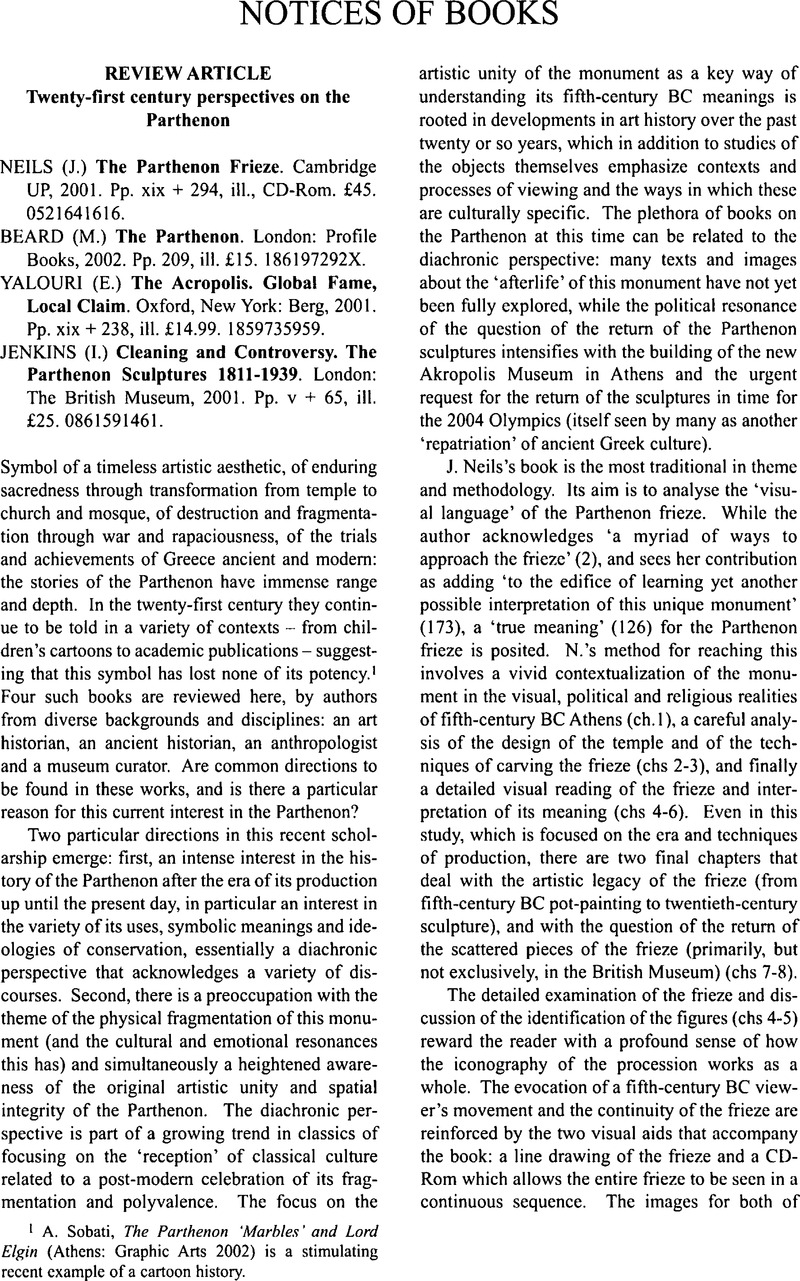No CrossRef data available.
Article contents
Twenty-first century perspectives on the Parthenon - (J.) Neils The Parthenon Frieze. Cambridge UP, 2001. Pp. xix + 294, ill., CD-Rom. £45. 0521641616. - (M.) Beard The Parthenon. London: Profile Books, 2002. Pp. 209, ill. £15. 186197292X. - (E.) Yalouri The Acropolis. Global Fame, Local Claim. Oxford, New York: Berg, 2001. Pp. xix + 238, ill. £14.99. 1859735959. - (I.) Jenkins Cleaning and Controversy. The Parthenon Sculptures 1811-1939. London: The British Museum, 2001. Pp. v + 65, ill. £25.0861591461.
Review products
Published online by Cambridge University Press: 23 February 2012
Abstract

- Type
- Notices of Books
- Information
- Copyright
- Copyright © The Society for the Promotion of Hellenic Studies 2003
References
1 Sobati, A., The Parthenon ‘Marbles’ and Lord Elgin (Athens: Graphic Arts 2002)Google Scholar is a stimulating recent example of a cartoon history.
2 B. does not go into further detail on this claim but modern Greek historians who at least attempt reasonableness on the subject of Greece under Ottoman rule might include N. Svoronos and E. Zachariadou (economic history of the Ottoman Empire), and K. Dimaras and P. Kitromilides (history of ideas in the later Ottoman Greek world).
3 Kavafis, K., Peza, ed. Papoutsakis, G.A. (Athens: Phexes 1963) 17–22Google Scholar (‘Ta Elgineia marmara’ and ‘Neotera peri ton Elgineion marmaron’); Seferis, G., Dokimes (Athens: Ikaros 1974) 1.125–34Google Scholar, especially 126-7 (‘Monologos pano sten poiese’, section 4 ‘Ta “athanata” erga’), and 2.312-32 (‘“Glosses” ston Artemidoro ton Daldiano’), 339-48 (‘Panta plere theon’). See Argyriou, A., ‘The Parthenon in the consciousness of Modern Greek poets and thinkers’, in Tournikiotis, P. (ed.), The Parthenon and its Impact in Modern Times, tr. by Cox, and Solman, (Athens: Melissa 1994) 342–5Google Scholar.
4 Orloff-Davidoff, V., Oi semeioseis apo to taxidi sta Ionia nesia, ten Ellada, ten Mikra Asia kai ten Tourkia 1835, tr. into Greek by Tsybénko, O. (Athens: Emporike Trapeza 2003)Google Scholar; Philippides, D. and Konstantas, G., Geographia Neoterike (1791), ed. Koumarianou, Aik. (Athens: Estia 2000): 154Google Scholar (on the Parthenon), 233 (on Delos); Strateigou Makriyianni Apomnemoneumata, ed. Vlahoyannis, Y. (Athens: E.G. Bagionake 1947) 2.63 (§303)Google Scholar. See also Seferis, G., Dokimes (Athens: Ikaros 1974) 1.228–63Google Scholar, especially 240-1 (‘Enas Ellinas — o Makriyannis’).
5 This film likens the use and appropriation of the Parthenon by (Greek and foreign) politicians, tourists and guides over the years to the prostitution of Greece and its culture. It does this through the visual juxtaposition of historical and contemporary footage of visits to the Parthenon with pornographic clips found in antique shops at the foot of the Akropolis.
6 Todorova, M., Imagining the Balkans (Oxford UP 1997)Google Scholar and Said, E., Orientalism (London: Penguin 1991)Google Scholar.
7 An illuminating recent example is the statement by N. MacGregor, director of the British Museum, made on 11 November 2002, available at http://www.thebritishmuseum.ac.uk/gr/newparth.doc (visited on 30 May 2003): ‘The British Museum is a truly universal museum of humanity, accessible to 5 million visitors from around the world every year entirely free of entry charge. Only here can the worldwide significance of the Parthenon sculptures be fully grasped.’ (emphasis added). See also the ‘Declaration on the importance and value of universal museums’ http://www.thebritishmuseum.ac.uk/gr/umstatement.doc (visited on 30 May 2003).
8 Clair, W. St ‘The Elgin Marbles: questions of stewardship and accountability’, International Journal of Cultural Property 8 no.2 (1999) 397–521CrossRefGoogle Scholar.
9 www.tschumi.com. I am grateful to Michael Photiadis for information about the museum design.
10 Dragona, P., ‘O pyretos ton marmaron’ in the architectural magazine Highlights 11 (December 2001) 68–71, especially 70-1Google Scholar.
11 Statement by N. MacGregor, director of the British Museum, made on 11 November 2002, available at www.thebritishmuseum.ac.uk/gr/grparth.html (visited on 30 May 2003): ‘The Parthenon itself has been much damaged since antiquity. The restoration of the integrity of the building is thus an unachievable goal.’


